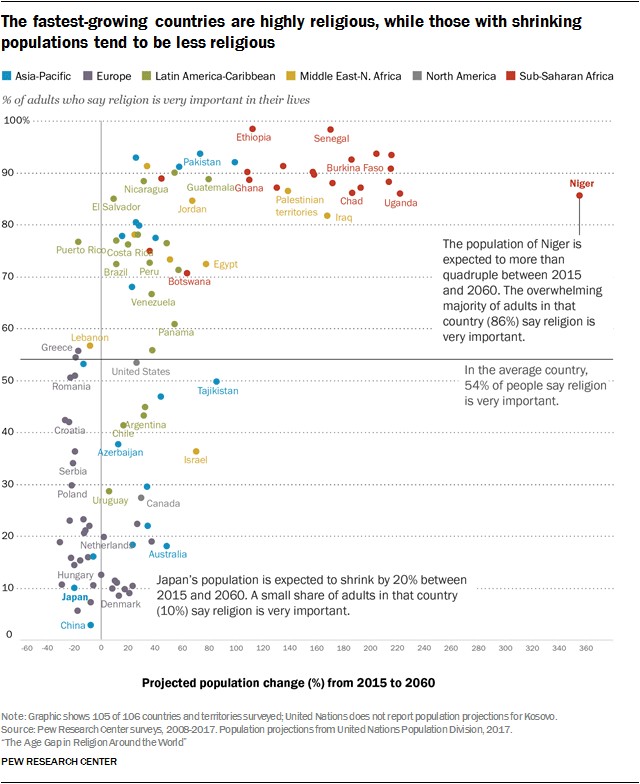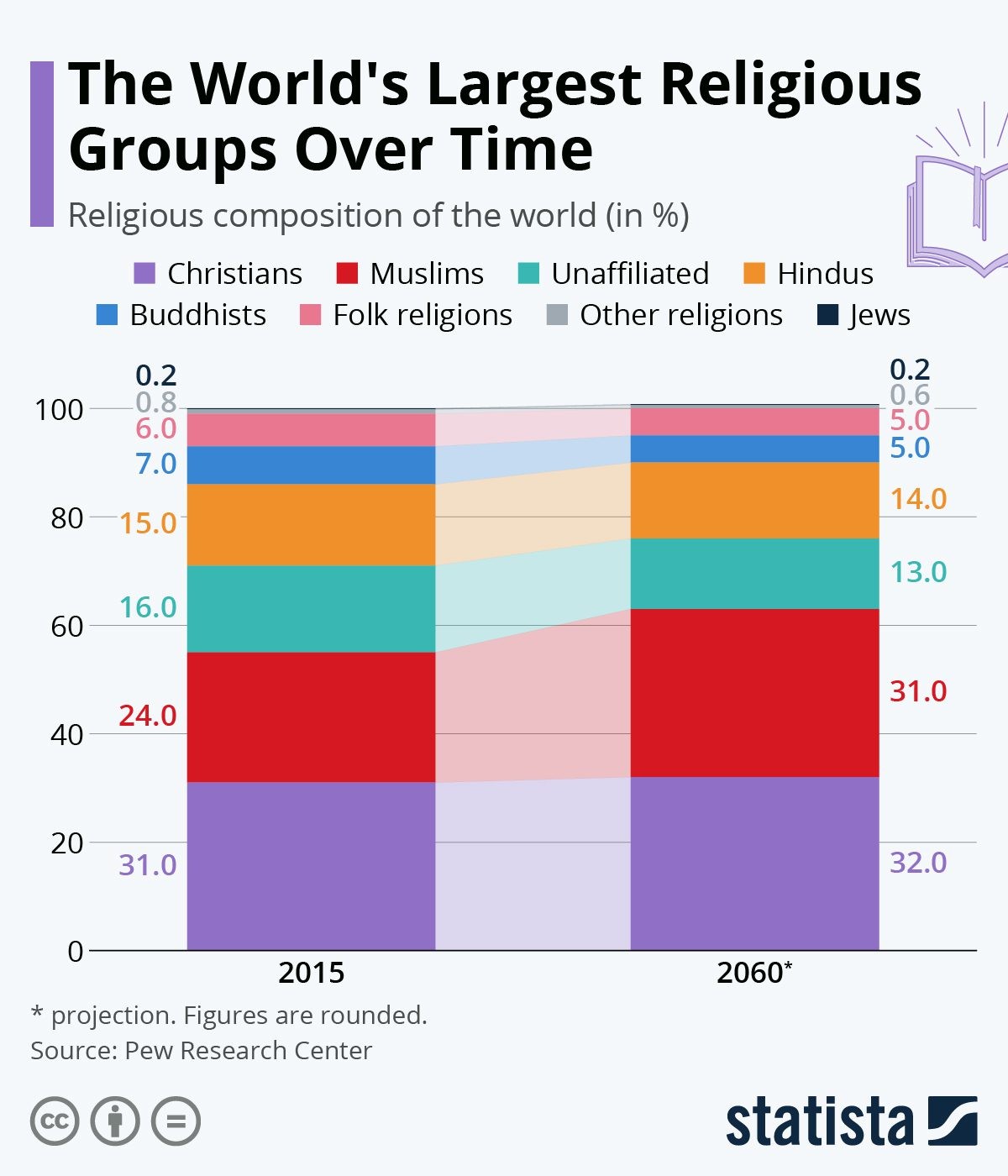Are you curious about the global distribution of Christianity and its impact on society? WHAT.EDU.VN offers a clear and concise answer to the question of what percentage of the world is Christian, while also exploring the broader landscape of religious demographics worldwide. We provide valuable insights into the prevalence of Christianity, its historical context, and its future trends, helping you understand the religious composition of our planet and the factors that shape it. Explore religious affiliation and its worldwide impact.
1. Understanding the Global Religious Landscape
Religion has played a pivotal role in shaping human civilization, influencing cultures, ethics, and social structures. It continues to be a significant aspect of life for billions of people worldwide. Let’s delve into the demographics of the world’s major religions.
1.1. What Defines Religion?
Religion encompasses a diverse range of belief systems, practices, and moral codes centered around the concept of the sacred or divine. Émile Durkheim, a prominent sociologist, considered religion a fundamental social institution that fulfills essential societal needs. These needs often include providing meaning, fostering social cohesion, and establishing moral guidelines.
1.2. How Many People Identify with a Religion?
Approximately 85% of the global population identifies with a religion. This demonstrates the widespread prevalence of religious belief and practice across various cultures and regions.
2. The Four Largest Religions in the World
Four major religions account for over three-quarters of the world’s religious population. They are Christianity, Islam, Hinduism, and Buddhism.
2.1. Christianity: Global Reach and Denominations
Christianity, originating in the Middle East nearly 2,000 years ago, boasts approximately 2.4 billion followers worldwide. This makes it the largest religion globally.
2.1.1. Where is Christianity Most Prevalent?
Christianity is the predominant religion in the Americas, Europe, Oceania, and sub-Saharan Africa.
2.1.2. What are the Major Christian Denominations?
- Catholic: Approximately half of all Christians identify as Catholic.
- Protestant: 37% of Christians are Protestant.
- Orthodox: 12% of Christians belong to the Orthodox tradition.
- Other: 1% identify with other Christian denominations.
2.1.3. Which Countries Have the Largest Christian Populations?
- United States: Home to the largest Christian population (11.3% of the world total).
- Brazil: Second-largest Christian population (8%).
- Mexico: Third-largest Christian population (5%).
2.2. Islam: Diversity and Global Presence
Islam, founded in 622 CE, has nearly 2 billion followers. The majority identify with the Sunni and Shia sects.
2.2.1. Where is Islam Most Prevalent?
Muslims reside in 49 countries, primarily in the Middle East, North Africa, and parts of South Asia.
2.2.2. Which Countries Have the Largest Muslim Populations?
- Indonesia: Largest Muslim population (13.1% of the world total).
- India: Second-largest Muslim population (11%).
- Pakistan: Third-largest Muslim population (10.5%).
- Bangladesh: Fourth-largest Muslim population (8.4%).
- Karachi, Pakistan: The city with the largest Muslim population.
2.3. Hinduism: Ancient Roots and Geographic Concentration
Hinduism, one of the oldest religions, originated in Northern India around 2000 BCE. It counts approximately 1.2 billion followers.
2.3.1. Where is Hinduism Most Prevalent?
The vast majority of Hindus live in India and Nepal.
2.4. Buddhism: Origins in India and Eastern Influence
Buddhism originated in Ancient India in the 5th century CE and has approximately 500 million followers.
2.4.1. Where is Buddhism Most Prevalent?
Countries with significant Buddhist populations include Mongolia, Thailand, Myanmar, Laos, and Cambodia. About half of the world’s Buddhists live in China.
3. Religions with Smaller Followings
A diverse array of religions have smaller followings compared to the four major religions, representing approximately 7% of the global population.
3.1. Judaism: Historical Significance and Modern Distribution
Judaism, one of the three major Abrahamic religions, has approximately 16 million followers (0.2% of the global population).
3.1.1. Where is Judaism Most Prevalent?
The majority of Jewish people reside in Israel (7 million) and the United States (6 million).
3.2. Folk and Traditional Religions: Cultural Heritage
Approximately 6% of the world’s population adheres to folk or traditional religions.
3.2.1. What are Examples of Folk and Traditional Religions?
These include African traditional religions, Chinese folk religions, Native American religions, and Australian aboriginal religions.
3.3. Other Faiths: A Tapestry of Beliefs
Approximately 1% of the world’s population follows various other faiths.
3.3.1. What are Examples of Other Faiths?
These include Baha’i, Taoism, Jainism, Shintoism, Sikhism, Tenrikyo, Zoroastrianism, Wicca, and many others.
4. The Non-Religious Population in the World
Around 16% of people worldwide do not identify with any particular religion.
4.1. Who are the “Nones”?
This group includes atheists, agnostics, and individuals who may believe in God or spiritual life but do not affiliate with a specific religion.
4.2. Which Countries Have the Largest Unaffiliated Populations?
The countries with the largest unaffiliated populations include China, Japan, and the United States.
4.3. Trends in Religious Affiliation
In the United States, the percentage of people who identify as “none” has grown from 8% in 2000 to 21% in 2022. In several countries, including China, Japan, South Korea, North Korea, Czechia, and Estonia, the majority of the population has no religious affiliation.
5. Fertility Rates and Religion
Fertility rates vary significantly across different religious groups and geographic regions, influencing population growth patterns.
5.1. Factors Influencing Population Growth
According to Pew Research, the most religious areas of the world are experiencing the fastest population growth due to high fertility rates and relatively young populations.
5.2. Examples of Population Growth and Religion
- Niger: The country with the fastest-growing population and the highest fertility rate. A vast majority of adults in Niger (86%) consider religion very important to their lives.
- Japan: A shrinking population with only 10% considering themselves religious. Japan’s population is expected to decline significantly over the next 50 years.
5.3. Fertility Rates in Islamic Countries
In 2015-2020, Muslims had the highest fertility rate among major religious groups (2.9).
5.3.1. Education and Fertility in Islamic Countries
Fertility rates in Muslim-majority countries are closely linked to educational attainment for women. Countries where girls complete fewer years of school have significantly higher fertility rates.
5.4. Christian Fertility Rate
The Christian population also continues to grow, with a fertility rate higher than the world average (2.6 in 2015-2020).
5.4.1. Regional Variations in Christian Fertility
Fertility rates among Christians are lowest in Europe (1.6) and highest in sub-Saharan Africa (4.4).
5.5. Fertility Rates for Other Religions
Fertility rates for Hindus (2.3) and Buddhists (1.6) are lower than for Christians and Muslims worldwide. The completed family size for those unaffiliated with a religion is considerably lower (1.6) than the world average.
5.6. Global Trends in Fertility Rates
Fertility rates are falling worldwide across all major religious groups, with predictions of convergence to replacement level (2.1) later this century.
5.6.1. Factors Driving Fertility Rate Decline
This decline is influenced by increased use of contraception, greater education and status for girls and women, improved access to health care, and economic growth.
6. Religion and Government
Religion often plays a role in a nation’s system of government, with some countries establishing official state religions.
6.1. Countries with State Religions
More than 20% of countries (43) have official state religions.
6.1.1. Islam as the Official Religion
Islam is the official religion in 27 countries in Asia, sub-Saharan Africa, North Africa, and the Middle East. Eight of these countries consider themselves “Islamic states.”
6.1.2. Christianity as the Established Religion
Several countries consider themselves Christian republics, with Christianity as the established religion, including Argentina, Costa Rica, Finland, Greece, Armenia, Samoa, Iceland, and Malta.
6.1.3. Other State Religions
Bhutan and Cambodia have Buddhism as their state religion, and Israel is officially a Jewish state. No country has Hinduism as its state religion.
6.2. Communism and Religion
In 10 countries, particularly those with a history of Communism, the state is hostile to religion or tightly regulates religious institutions. These include China, Cuba, North Korea, Vietnam, and several former Soviet republics.
7. The Future of Religion Throughout the World
While the number of religiously unaffiliated individuals is growing in some regions, the overall trend worldwide suggests continued growth in religious affiliation.
7.1. Expected Changes in Religious Affiliation
The proportion of those who don’t affiliate with a religion is expected to decrease from 16 to 13 percent by 2060.
7.2. Growth of Islam and Christianity
The numbers of Muslims and Christians are both expected to grow significantly. By later in the 21st century, Muslims are projected to be the largest religious group in the world.
7.2.1. Regional Growth of Islam
The growth of Islam will be most noticeable in sub-Saharan Africa, which is the fastest-growing region of the world.
7.2.2. Regional Growth of Christianity
Christianity is expected to grow significantly in Africa, with 4 out of every 10 Christians in the world living in sub-Saharan Africa by 2050.
7.3. Growth of Other Religions
Only modest growth is expected in the number of Hindus and Buddhists worldwide over the next 30 years.
7.4. Factors Influencing Religious Demographics
Population shifts and demographic changes, such as birth rates, migration patterns, and religious conversion, can influence the distribution and prevalence of different religions globally.
8. The Significance of Religious Demographics
Religious demographics play a crucial role in shaping societies and influencing various aspects of human life.
8.1. Religion as a Source of Conflict and Cooperation
Religion can be a source of both conflict and cooperation. While some conflicts are driven by religious differences, religions can also play a positive role in promoting peace, social justice, humanitarian efforts, and conservation efforts.
8.2. Influence on Gender Roles and Family Size
Religious practice can influence gender roles and desired family size, but it is only one factor among many. People of all religious backgrounds are influenced by cultural, social, and economic trends when making decisions about relationships and family planning.
9. Frequently Asked Questions (FAQs) About Religious Demographics
| Question | Answer |
|---|---|
| What is the most followed religion in the world? | Christianity is the most followed religion in the world, with approximately 2.4 billion followers. |
| Which region has the highest concentration of Christians? | Christianity is most prevalent in the Americas, Europe, Oceania, and sub-Saharan Africa. |
| How many Muslims are there worldwide? | There are nearly 2 billion Muslims worldwide, primarily concentrated in the Middle East, North Africa, and parts of South Asia. |
| Where do most Hindus live? | The vast majority of Hindus live in India and Nepal. |
| What is the future of religious demographics? | While some regions see a rise in non-religious individuals, overall, religious affiliation is expected to grow, with Islam and Christianity showing significant growth. |



10. Conclusion: Understanding Religious Demographics with WHAT.EDU.VN
Understanding the global religious landscape is essential for fostering cross-cultural understanding and promoting peaceful coexistence. Christianity, with its vast global reach and diverse denominations, remains a significant force in shaping societies worldwide. At WHAT.EDU.VN, we strive to provide clear, accurate, and accessible information on religious demographics and related topics, empowering you to explore the complexities of our world with confidence.
Do you have more questions about religious demographics or other topics? Visit WHAT.EDU.VN today to ask your questions and receive free answers from our knowledgeable community. We are dedicated to providing a platform where curiosity is encouraged and answers are readily available. Contact us at 888 Question City Plaza, Seattle, WA 98101, United States. Reach out via Whatsapp at +1 (206) 555-7890 or visit our website what.edu.vn.
Seeking quick, free answers to your questions?